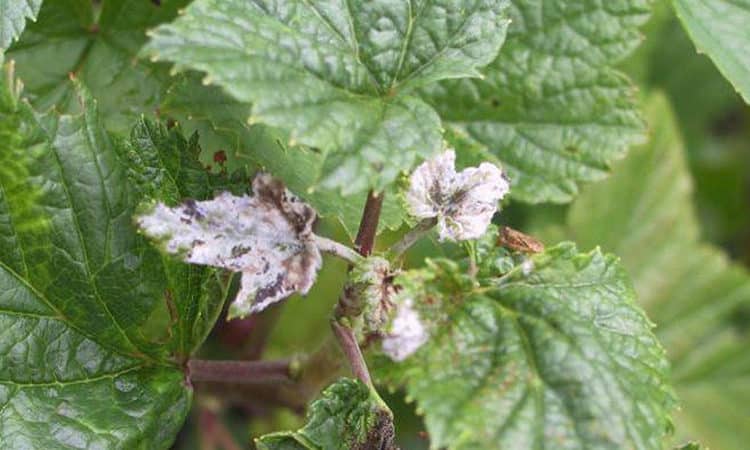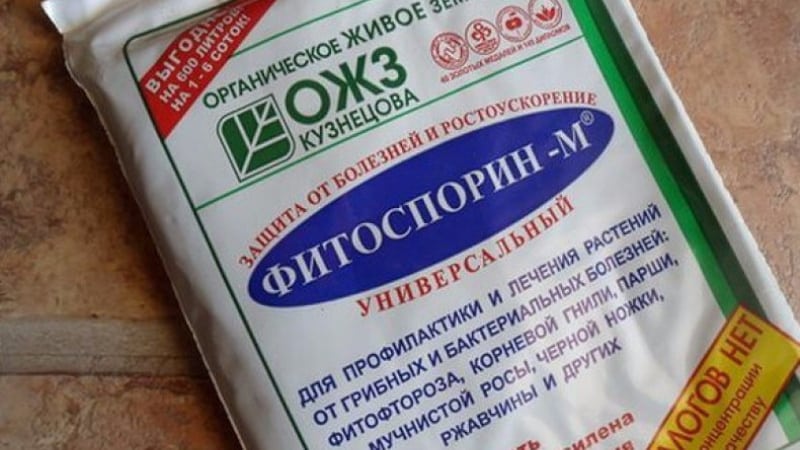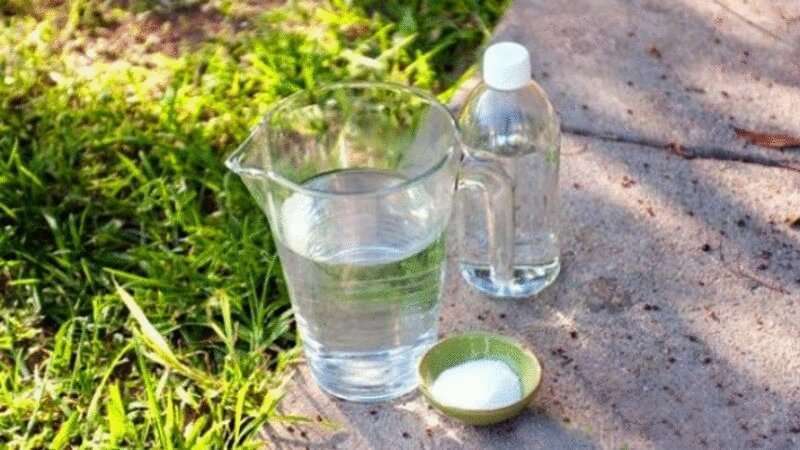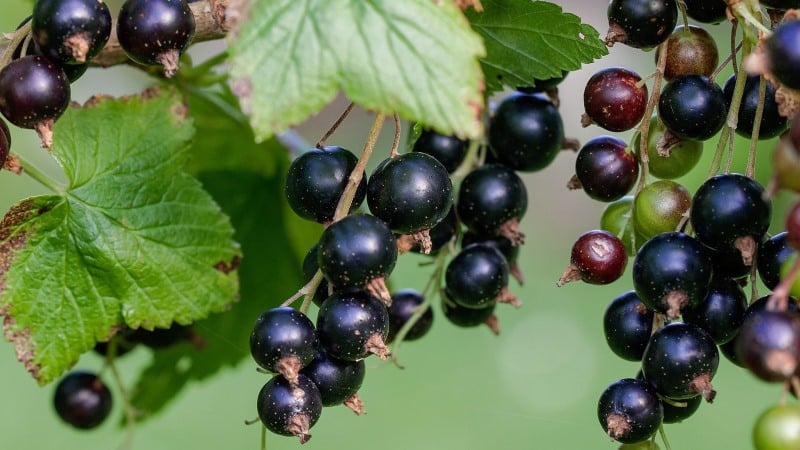How to treat white plaque on currant leaves: chemicals and folk remedies
In late spring - early summer, gardeners often find a white coating on currant leaves. What does it mean and how to treat the shrub so as not to harm the crop?
The disease cannot be ignored, because it can appear from year to year, affecting not only currants, but also neighboring plants. And processing alone is not enough. An integrated approach is important, including compliance with the rules of agricultural technology, preventive measures and the treatment itself.
What does white bloom on currant leaves mean?
A dense coating (usually gray) on young leaves and shoots of currants is the final stage of mycosis of the plant. At the initial stage, you can notice whitish spots and transparent drops.
This is a fungal disease - powdery mildew. Its development is provoked by several species of parasitic fungi of the genus Spheroteca. There are also names: berry death, bel, ashtray.
For reference. The period of distribution of fungal spores occurs at the end of April - beginning of May. In June, you can already notice the first signs of damage on the leaves and ovaries of currants.
There are no plant varieties that are completely resistant to the disease. Black currants require special attention. In the first year shrub planting the fungus is capable of destroying more than 70-80% of the crop.
Some varieties have been bred that can resist the disease for a long time and are easy to treat.In other cases, the fight against powdery mildew must be comprehensive, otherwise you may be left without a harvest.

How to spray currants against powdery mildew
In most cases, the disease develops due to high temperature and humidity. Therefore, along with processing the plant, you need to follow some recommendations in order to neutralize provoking factors:
- Avoid spraying with water; drip irrigation is recommended;
- refuse nitrogen stimulation;
- allow slight shade only on hot days.
How to treat white plaque on currant leaves? It is better to combine chemicals and folk remedies. The latter are ineffective as an independent method. Their effect stops after rain or strong wind. Chemicals are poisonous and hazardous to health, which precludes frequent use.
For reference. After the ovary has formed, treatment with chemicals is prohibited.
Chemicals
Biofungicides and fungicides are used to protect plants. Fungicides are effective but toxic. Often several treatments are sufficient per season. Biological preparations have a short duration of action and are water-soluble, which requires subsequent treatments at least once every 5-7 days. These products are practically harmless to health.
Let's talk about the most common biofungicides.
“Fitosporin”
Suppresses the growth of mycelium (mushroom body). Can be used at any time at any stage of plant development. But, as practice shows, the drug is effective only at the initial stage of fungal activity.
Sold in the form of powder, aqueous suspension and paste. It is diluted strictly according to the instructions. Accepted consumption rate: 5 g of powder per 10 liters of water.Use it exclusively in cloudy weather or in the evening.

"Trichodermin"
A drug with a pronounced antifungal effect based on bioactive substances released during spore germination. Stimulates plant growth, fertilizes soil. Does not affect the taste of berries, harmless to the body.
Available in the form of powder and aqueous suspension. A mother solution is prepared from the powder: with constant stirring, 1 package is diluted in 1 liter of warm water and left for 1-2 hours in a warm place.
“Trichophyte”
Analogue of “Fitosporin” and “Trichodermin”. Non-toxic. In addition to destroying pathogens, it enriches the soil with small doses of nitrogen, potassium, phosphorus, iron, copper, and sulfur. Shows high efficiency in the fight against plant mycosis.
Available in the form of a suspension. Treatments can only be carried out at night. Consumption rate for garden crops: 100 g per 10 liters of water.
Attention! When using the following group of drugs, precautions are required: work in a protective mask, clothing and gloves, carry out processing in dry and windless weather.
“Bordeaux liquid”
Contact pesticide. It is a mixture of copper sulfate, lime and water. After application, it protects the plant for a month.
When shrubs are partially infected, three procedures are recommended: before leaves bloom, at the beginning of the growing season and after flowering. If all plants are affected, the number of treatments is increased to six. The latter is carried out no later than 2-3 weeks before harvest.

“Previkur”
A product with pronounced fungicidal and biostimulating effects. Used for spraying, drip irrigation, root irrigation. Consumption rate: 5 ml of the drug per 1 liter of water.The treatment is carried out in inactive sun.
Important! When preparing the mixture, the pH of the water should be 5.5. In alkaline or highly alkaline water, the product loses its effectiveness.
"Topaz"
A systemic drug based on penconazole is available in the form of a solution. Suppresses mycelial growth 3 hours after initial use. Can be used in any weather conditions. Well compatible with other fungicides. Dosage: 2 ml of product per 10 liters of water. First stir in 2 liters of water, then gradually add 8 liters.
“Fundazol”
Broad-spectrum fungicide based on benomyl. In the first three days after treatment, it suppresses the development of fungi and destroys cells. In the next seven days it works as a protective agent.
Sold in the form of powder, packaged in 10 g. The solution is prepared at the rate of 1 g per 1 liter of water. Repeated treatment of plants is allowed with mandatory adherence to the time interval.
"Vectra"
The drug has a contact-systemic, protective and therapeutic action. The product is compatible with most fungicides and insecticides that do not have an alkaline reaction.
The treatment is carried out with a freshly prepared solution during the growing season at the first manifestations of the fungus. It is better to spray in dry and windless weather, in the morning or evening, 6 hours before possible precipitation. Consumption rate: 2-3 ml of product per 10 liters of water.
Folk remedies

At the initial stage of the disease, you can try folk remedies. Recipes include healthy ingredients:
- Baking soda and laundry soap. Dissolve an equal amount of soda and grated soap (50 g each) in 10 liters of hot water. Stir and let cool. Process leaves on both sides.The time interval between treatments is 1 week, the frequency of treatments is until powdery mildew completely disappears.
- Whey or kefir. Mix one part of a fermented milk product (optional) with 10 parts of water. Spray three times in a row for three days. After rain, repeat the procedure unscheduled.
- Potassium permanganate. Dissolve 0.5 tsp in 10 liters of water. potassium permanganate. Irrigate the plant three times, repeating the procedure every seven days.
- Ash and laundry soap. Pre-sifted 1 kg of ash pour 10 liters of water. Let it brew for 4-5 days, stirring occasionally. Then add 2 tbsp. l. grated laundry soap and strain. Carefully process the leaves on both sides.
You should not rely only on traditional methods; with an integrated approach, you can achieve treatment results much faster.
What to treat in different seasons
Processing currant bushes consists of several stages: spring, summer and autumn. Neglecting any of them risks losing the harvest next season. The summer stage requires spraying with chemicals before the berries ripen. If necessary, treatment is supplemented with biological products.
In the fall, it is important to burn old branches, fallen leaves and shoots. The tree trunk circle is completely cleared of leaves and fertilized. Autumn fertilizing should contain potassium chloride and superphosphate.
For reference. It is better to avoid nitrogen-containing fertilizers in the fall so as not to provoke active shoot growth.
in spring
The spring stage of processing is the largest. One of the surest methods of prevention is replacing the top fertile soil with new humus, for example, vermicompost. Most of the overwintered fungal spores leave along with the old soil.

Treatment of currants in the spring against powdery mildew also includes:
- Irrigation of bushes with boiling water until the snow melts. They are carried out in March - early April, depending on the climate - it is important to do it before the buds open. It is more convenient to spray the bushes with a watering can and sprayer. For each bush take 5-6 liters of boiling water. Maintain a distance of 10 cm from the bush to the watering can. Processing time for each plant is no more than 5 seconds. Irrigation with boiling water is carried out only once
- Treatment of the tree trunk circle with tansy solution. Recipe: 80 g of dry raw materials are soaked in 10 liters of water for 24 hours, then brought to a boil, boiled for 20 minutes, filter the solution. Before use, dilute with water in a ratio of 1:5. Spray the plants in early spring.
- Spraying with a solution of copper sulfate until the buds swell. To prepare a 0.5-1% solution, 50-100 g of the product are diluted in 10 liters of water. The procedure is carried out at positive temperatures. They cultivate the branches and the ground under the bushes.
- Moisture-charging irrigation. Suitable for use in case of spring moisture deficiency after a winter with little snow. Water should not get on the trunk and around it - step back 12-15 cm from the center and water the soil with a hose.
- Spraying the plant before flowering with the listed fungicides and biological products at least 3-4 times per season in accordance with the instructions.
The solution should reach all parts of the leaves. As a rule, spraying occurs before flowering, during flowering and immediately after.
During fruiting
During the period of berry ripening, irrigation with fungicides is stopped due to their toxicity. As an alternative, biological drugs are used, but the frequency of treatment is increased. It is also appropriate to use folk remedies.
This is interesting:
How and when to collect currant and raspberry leaves for drying for the winter.
Conclusion
Powdery mildew is a common disease with characteristic symptoms. Depending on the season, measures to combat the spheroteca vary. Folk remedies are used as disease prevention.
With progression, it is better to begin treatment with biofungicides or fungicides, in this case the likelihood of preserving the crop increases.